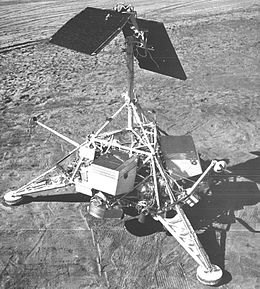 Surveyor model on Earth | |
| Mission type | Lunar lander |
|---|---|
| Operator | NASA |
| COSPAR ID | 1967-112A |
| SATCAT no. | 03031 |
| Mission duration | 37 days (launch to last contact) |
| Spacecraft properties | |
| Manufacturer | Hughes Aircraft |
| Launch mass | 1,008.3 kilograms (2,223 lb)[1] |
| Landing mass | 299.6 kilograms (661 lb) after landing |
| Start of mission | |
| Launch date | November 7, 1967, 07:39:01 UTC [1] |
| Rocket | Atlas SLV-3C Centaur-D AC-14 |
| Launch site | Cape Canaveral LC-36B |
| End of mission | |
| Last contact | December 14, 1967; last useful data November 24 |
| Lunar lander | |
| Landing date | November 10, 1967, 01:01:06 UTC |
| Return launch | November 17, 1967, 10:32 UTC |
| Landing site | 0°28′N 1°22′W / 0.46°N 1.37°W[2] |
| Lunar lander | |
| Landing date | November 17, 1967 |
| Landing site | 2.5 metres (8 ft 2 in) west of original landing site[2] |
Surveyor 6 is the sixth lunar lander of the American uncrewed Surveyor program that reached the surface of the Moon. Surveyor 6 landed on the Sinus Medii. A total of 30,027 images were transmitted to Earth.
This spacecraft is the fourth of the Surveyor series to successfully achieve a soft landing on the Moon, obtain post landing television pictures, determine the abundance of the chemical elements in the lunar soil, obtain touchdown dynamics data, obtain thermal and radar reflectivity data, and conduct a Vernier engine erosion experiment. Virtually identical to Surveyor 5, this spacecraft carried a television camera, a small bar magnet attached to one footpad, and an alpha-scattering instrument as well as the necessary engineering equipment. It landed on November 10, 1967, in Sinus Medii, 0.49 deg in latitude and 1.40 deg w longitude (selenographic coordinates)–the center of the Moon's visible hemisphere. The spacecraft accomplished all planned objectives. The successful completion of this mission satisfied the Surveyor program's obligation to the Apollo project. On November 24, 1967, the spacecraft was shut down for the two-week lunar night. Contact was made on December 14, 1967, but no useful data was obtained.
Lunar soil surveys were completed using photographic and alpha particle backscattering methods. A similar instrument, the APXS, was used onboard several Mars missions.[3]
In a further test of space technology, Surveyor 6's engines were restarted and burned for 2.5 seconds in the first lunar liftoff on November 17 at 10:32 UTC. This created 150 lbf (700 N) of thrust and lifted the vehicle 12 feet (4 m) from the lunar surface. After moving west eight feet, (2.5 m) the spacecraft once again successfully soft landed and continued functioning as designed.
Surveyor 6 landed near the crash site of Surveyor 4, which malfunctioned a few months earlier in July 1967.
- ^ a b "Surveyor 6". NASA's Solar System Exploration website. Retrieved 2022-12-02.
- ^ a b "In Depth | Surveyor 6". NASA Solar System Exploration. Retrieved 2022-01-07.
- ^ NASA, JPL. "Alpha Particle X-Ray Spectrometer (APXS) – Mars Science Laboratory". mars.nasa.gov. Retrieved 2016-11-25.